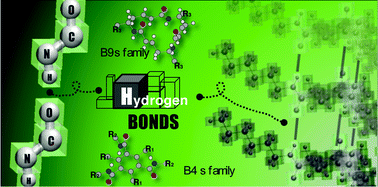Computational prediction of the supramolecular self-assembling properties of organic molecules: the role of conformational flexibility of amide moieties†
Abstract
Two families of organic molecules with different backbones have been considered. The first family is based on a macrolactam-like unit that is constrained in a particular conformation. The second family is composed by a substituted central phenyl that allows a larger mobility for its substituents. They have however a common feature, three amide moieties (within the cycle for the macrolactam-like molecule and as substituents for the phenyl) that permit hydrogen bonding when molecules are stacked. In this study we propose a computational protocol to unravel the ability of the different families to self-assemble into organic nanotubes. Starting from the monomer and going towards larger assemblies like dimers, trimers, and pentamers we applied the different protocols to rationalize the behavior of the different assemblies. Both structures and thermodynamics were investigated to give a complete picture of the process. Thanks to the combination of a quantum mechanics approach and molecular dynamics simulations along with the use of tailored tools (non covalent interaction visualization) and techniques (umbrella sampling), we have been able to differentiate the two families and highlight the best candidate for self-assembling purposes.



 Please wait while we load your content...
Please wait while we load your content...